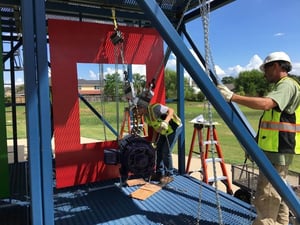Bull Rigging: What is that?
What is Bull Rigging? For those not well-versed in the terminology, it may conjure up images of thrilling rides on a rigging setup. However, that is not what Bull Rigging entails. In essence, Bull Rigging is a specialized rigging method utilized when a crane (whether mobile or overhead) cannot directly access the load. This technique, also known as drifting, "tarzaning," or hand rigging, operates independently from cranes but is often paired with other rigging tasks, such as moving a load from a structure to a crane hook or the other way around. Moreover, the process of rigging for cranes is essential for lifting and transporting heavy loads, demonstrating the variety of techniques employed in rigging operations.
The equipment commonly used in Bull Rigging includes:
- Chain Falls
- Come-a-longs or Lever Hoists
- Rollers/Casters/Skates
- Jacks (mechanical or hydraulic)
- Winches
- Rigging Blocks
Effectively planning and executing the use of chain hoists and similar devices for load drifting (moving loads horizontally while suspended), skidding or skating loads (pulling loads horizontally on rollers or other equipment), or building a winch and block system to assist with these tasks, demands a high level of expertise and careful consideration of the forces at play in rigging systems. Specialized Bull Rigging Training equips your team with essential knowledge and skills for successful bull rigging operations.
So, what does it take to become a Bull Rigger?
Initially, mastering the functions and applications of equipment is crucial! Furthermore, grasping the principles behind various load handling scenarios is essential for becoming a skilled and proficient Bull Rigger. This foundational knowledge should emphasize these six key elements of Bull Rigging Training:
- Estimating load weight.
- Identifying the center of gravity (C/G) and its impact on the load.
- Assessing load weight distribution and recognizing the share of the weight.
- Grasping tension when working with angles, as well as level or off-level pick points, and understanding the effects on both the rigging and the supporting structure.
- Calculating the force needed to pull a load up an incline or to hold a load back while lowering.
- Determining mechanical advantage, along with related block loading and frictional gain in a multi-part winch/block system.
To enhance your skills as a Bull Rigger, visit http://www.iti.com/bull-rigging to learn more about bull rigging training courses and register for upcoming open enrollment courses.
Interested in seeing some bull rigging in action? Check out the video!




COMMENTS